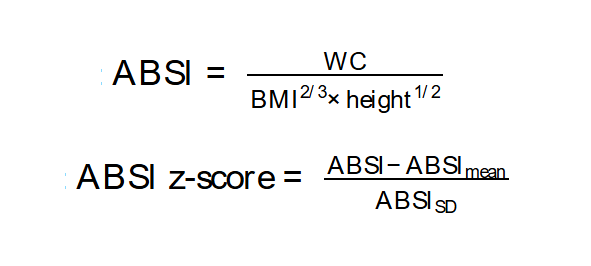1. What is an A Body Shape Index Calculator?
Definition: This calculator computes the A Body Shape Index (ABSI) and ABSI z-score, metrics that assess health risks associated with body fat distribution, using age, sex, height, weight, and waist circumference. ABSI focuses on abdominal obesity by incorporating waist circumference, unlike BMI, which only uses height and weight.
Purpose: It aids in health assessments by estimating the risk of premature mortality and obesity-related conditions like cardiovascular disease, type 2 diabetes, and certain cancers, providing a more nuanced view than BMI alone.
2. How Does the Calculator Work?
The calculator takes age, sex, height, weight, and waist circumference, with selectable units, and computes:
- ABSI:
- Formula: \( \text{ABSI} = \frac{\text{WC}}{\text{BMI}^{2/3} \times \text{height}^{1/2}} \), where WC and height are in meters, and BMI is in kg/m².
- Measures waist circumference relative to height and BMI, indicating abdominal fat distribution.
- ABSI z-score:
- Formula: \( \text{ABSI z-score} = \frac{\text{ABSI} - \text{ABSI}_{\text{mean}}}{\text{ABSI}_{\text{SD}}} \), using age- and sex-specific mean and standard deviation.
- Standardizes ABSI against a reference population to assess relative risk.
Unit Conversions:
- Length: cm, m, in, ft (e.g., 1 m = 100 cm = 39.3701 in).
- Weight: kg, lb, oz (e.g., 1 kg = 2.20462 lb).
Steps:
- Select your sex (female or male).
- Input your age (2–85 years).
- Input height, weight, and waist circumference with chosen units.
- Compute ABSI and ABSI z-score, formatted to 4 decimal places.
3. Importance of ABSI Calculations
Calculating ABSI and ABSI z-score is crucial for:
- Health Risk Assessment: ABSI identifies risks from abdominal obesity, which BMI overlooks, as abdominal fat is linked to higher cardiovascular and metabolic disease risks.
- Complementary to BMI: ABSI is independent of BMI, providing a better assessment of body shape-related risks, especially for those with normal BMI but high waist circumference.
- Personalized Insights: ABSI z-score compares your risk to a population average, helping tailor lifestyle interventions like diet or exercise to reduce abdominal fat.
4. Using the Calculator
Examples:
- Female: Age = 23 years, Height = 68 in (1.7272 m), Weight = 70 kg, Waist = 33 in (0.8382 m)
BMI: \( 70 / (1.7272)^2 \approx 23.4674 \).
ABSI: \( 0.8382 / (23.4674^{2/3} \times 1.7272^{1/2}) \approx 0.0808 \).
Mean (age 23, female) ≈ 0.0726, SD ≈ 0.0052 (interpolated).
ABSI z-score: \( (0.0808 - 0.0726) / 0.0052 \approx 1.5769 \).
- Male: Age = 30 years, Height = 175 cm (1.75 m), Weight = 80 kg, Waist = 90 cm (0.9 m)
BMI: \( 80 / (1.75)^2 \approx 26.1224 \).
ABSI: \( 0.9 / (26.1224^{2/3} \times 1.75^{1/2}) \approx 0.0836 \).
Mean (age 30, male) ≈ 0.0728, SD ≈ 0.0042 (interpolated).
ABSI z-score: \( (0.0836 - 0.0728) / 0.0042 \approx 2.5714 \).
5. Frequently Asked Questions (FAQ)
Q: What does a high ABSI z-score mean?
A: A positive ABSI z-score (e.g., >0) indicates your waist circumference is larger than average for your height and weight, suggesting higher health risks like cardiovascular disease or diabetes. An ABSI above 0.798 signals elevated mortality risk.
Q: How is ABSI different from BMI?
A: ABSI includes waist circumference to focus on abdominal fat distribution, which BMI ignores. ABSI is less dependent on height and weight, making it a better indicator of shape-related health risks.
Q: Why can I choose different units for measurements?
A: The calculator allows flexible unit selection for height, weight, and waist circumference to accommodate various measurement preferences, converting all inputs to standard units (m, kg) for accurate ABSI calculation.
 Home
Home
 Back
Back
